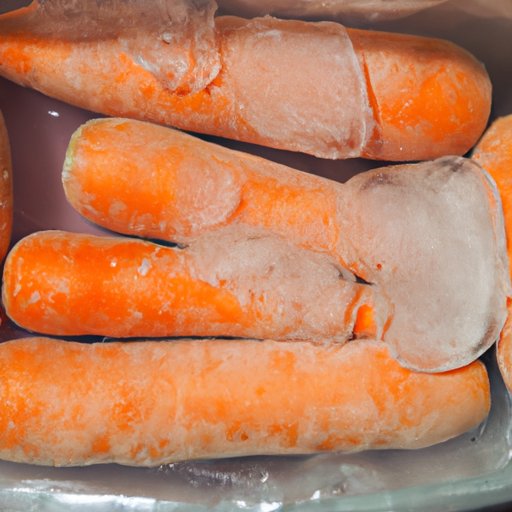
Introduction
Carrots are a delicious and nutritious vegetable that can be used in a wide variety of recipes. Whether you purchase your carrots from the grocery store or grow them in your garden, freezing them can be a great way to preserve their freshness and flavor for future use. In this article, we’ll explore the best practices for freezing carrots so that you can enjoy them all year round. This beginner’s guide is perfect for anyone who wants to learn how to freeze carrots for long-term storage.
A Beginner’s Guide to Freezing Carrots: Tips and Tricks for Long-term Storage
Freezing carrots is an excellent way to preserve their nutrients, reduce food waste, and enjoy fresh produce even when it’s out of season. Here are some tips and tricks for selecting the best carrots for freezing:
Choose fresh, firm, and brightly colored carrots that are uniform in size. The smaller carrots are better suited for freezing because they have a better texture, and they freeze and thaw more quickly. Before freezing, make sure to peel, wash, and trim the ends of the carrots.
Blanching carrots is an important step that helps preserve their texture and color. To blanch carrots, bring a large pot of water to a boil, add the carrots, and boil for 2-3 minutes. Drain them, then immediately transfer them to a bowl of ice water to stop the cooking process. Once they are cooled, you can spread them out on a baking sheet to dry.
Once your carrots have been blanched and dried, it’s time to pack them into the appropriate container for freezing. Freezer bags, plastic containers, and vacuum-sealed bags are all viable options for storing your carrots. Be sure to label each container with the date of freezing and the contents.
Preserving the Best of Harvest Season: How to Freeze Carrots for Future Use
If you’re interested in enjoying fresh produce all year round, freezing carrots is an excellent way to stock up on your favorite vegetables. Here are some specific techniques for freezing carrots so that you can get the most out of your harvest:
If you have a vacuum sealer, consider using it to freeze your carrots. Vacuum sealing removes excess air and helps prevent freezer burn, which can affect the quality of your frozen vegetables. Alternatively, freezer bags can be used to store your carrots if they are placed in a single layer, with excess air removed.
When it’s time to thaw your carrots, be sure to remove them from the freezer at least 24 hours in advance. This will give them enough time to defrost gradually. If you’re in a hurry, you can defrost them in the microwave using the defrost setting. Just be sure to watch them carefully to prevent overheating.
To store frozen carrots for long-term use, keep them in the freezer at a constant temperature of 0°F or below. Proper storage will help prevent freezer burn and ensure that your vegetables keep their texture and flavor.
Maximizing Your Meal Planning with Frozen Carrots: Step-by-Step Guide
Frozen carrots can be used in a wide variety of recipes, from casseroles to soups to side dishes. Here’s a step-by-step guide to using frozen carrots in your recipes:
If you’re using your frozen carrots in a recipe, you may need to adjust your cooking time accordingly. Frozen vegetables take longer to cook than fresh vegetables, so it’s important to take this into account. Be sure to follow the cooking directions carefully, and add your frozen carrots at the appropriate time.
From Garden to Freezer: Understanding the Best Practices for Freezing Carrots
If you grow your own carrots or purchase them from a farmer’s market, you may have a surplus of produce that you’d like to freeze. Here are some tips for harvesting and preserving fresh carrots for freezing:
Harvest your carrots when they are mature, typically 60-80 days after planting. The best time to pick them is in the early morning when the soil is cool and moist. After harvesting, treat your carrots with care, washing, peeling, and cutting them to the desired size, and then blanching them before freezing.
When freezing homegrown carrots versus store-bought carrots, homegrown carrots typically have a better taste and texture, due to their higher sugar content.
Simple and Effective Methods for Freezing Carrots: Ready for Any Recipe
Here are some additional tips and tricks for freezing carrots:
Before freezing, you can pack carrots into plastic bags or containers, with excess air removed. This can help preserve their texture. However, be sure to only pack them in one layer for the optimum result.
When using frozen carrots in a recipe, keep in mind that they have a higher water content than fresh carrots, since blanching causes water to enter the vegetable’s cells. Adjust your recipe accordingly, or use them in soups and stews where the added liquid is welcome.
Finally, if you’re not sure how to use your frozen carrots, experiment! They’re a versatile and healthy addition to many recipes, and can even be eaten as a snack.
Conclusion
Freezing carrots is an excellent way to preserve the flavor and nutrition of fresh carrots, reduce food waste, and increase meal planning flexibility. We hope that this beginner’s guide has given you some useful tips for freezing carrots, and that you now have the knowledge and confidence to freeze your own carrots at home. Whether you’re buying carrots from the grocery store or growing them yourself, freezing them is a simple and effective way to enjoy fresh produce all year round.




